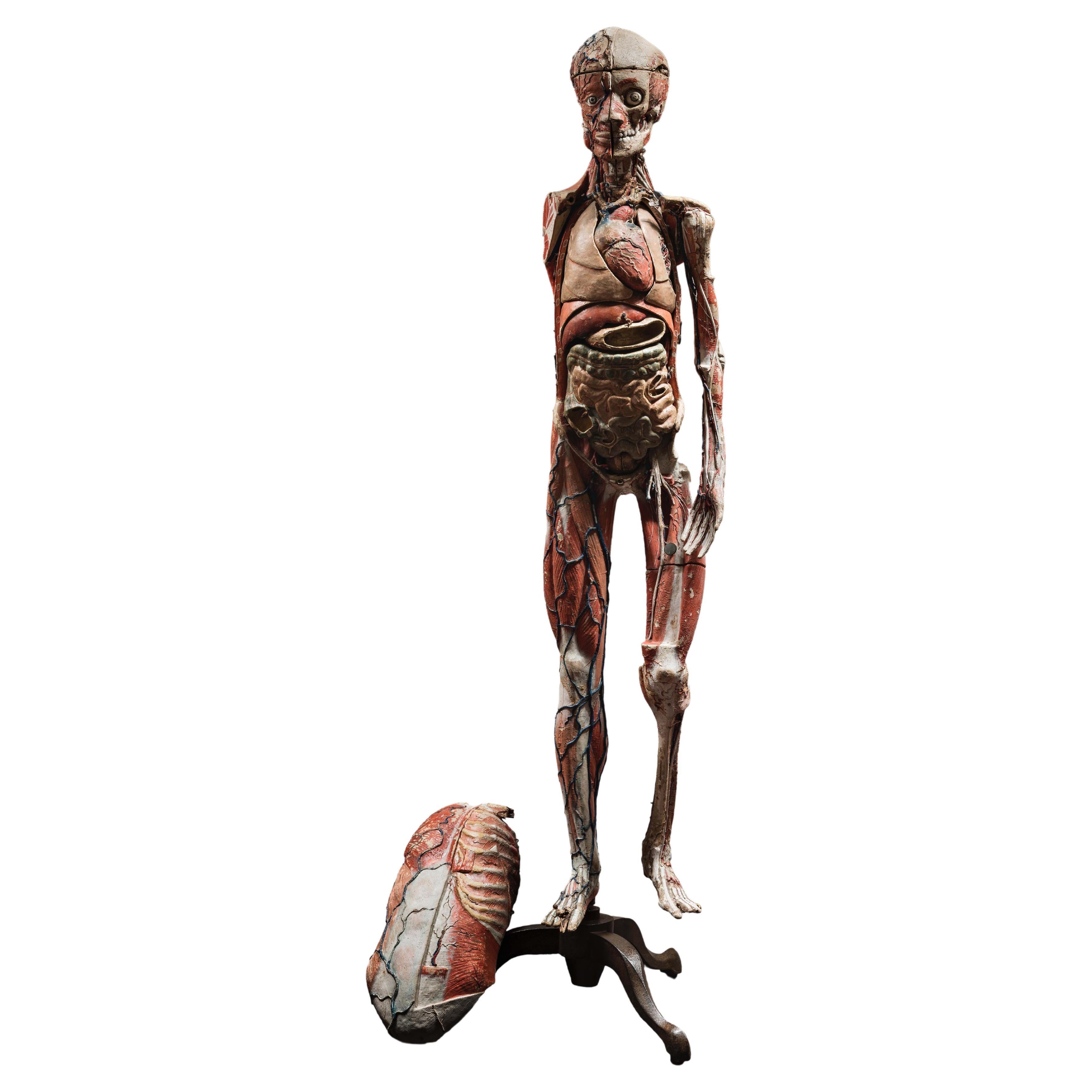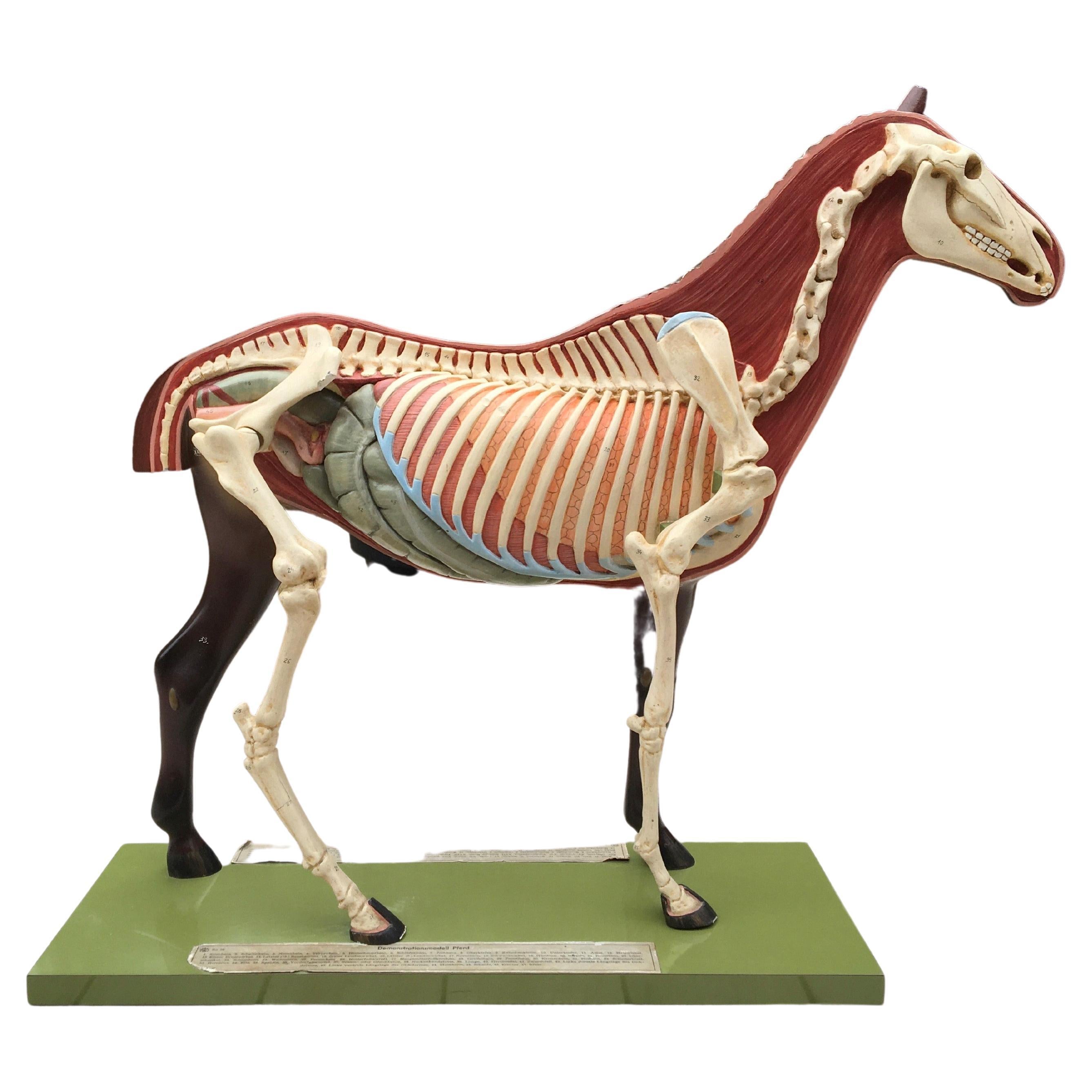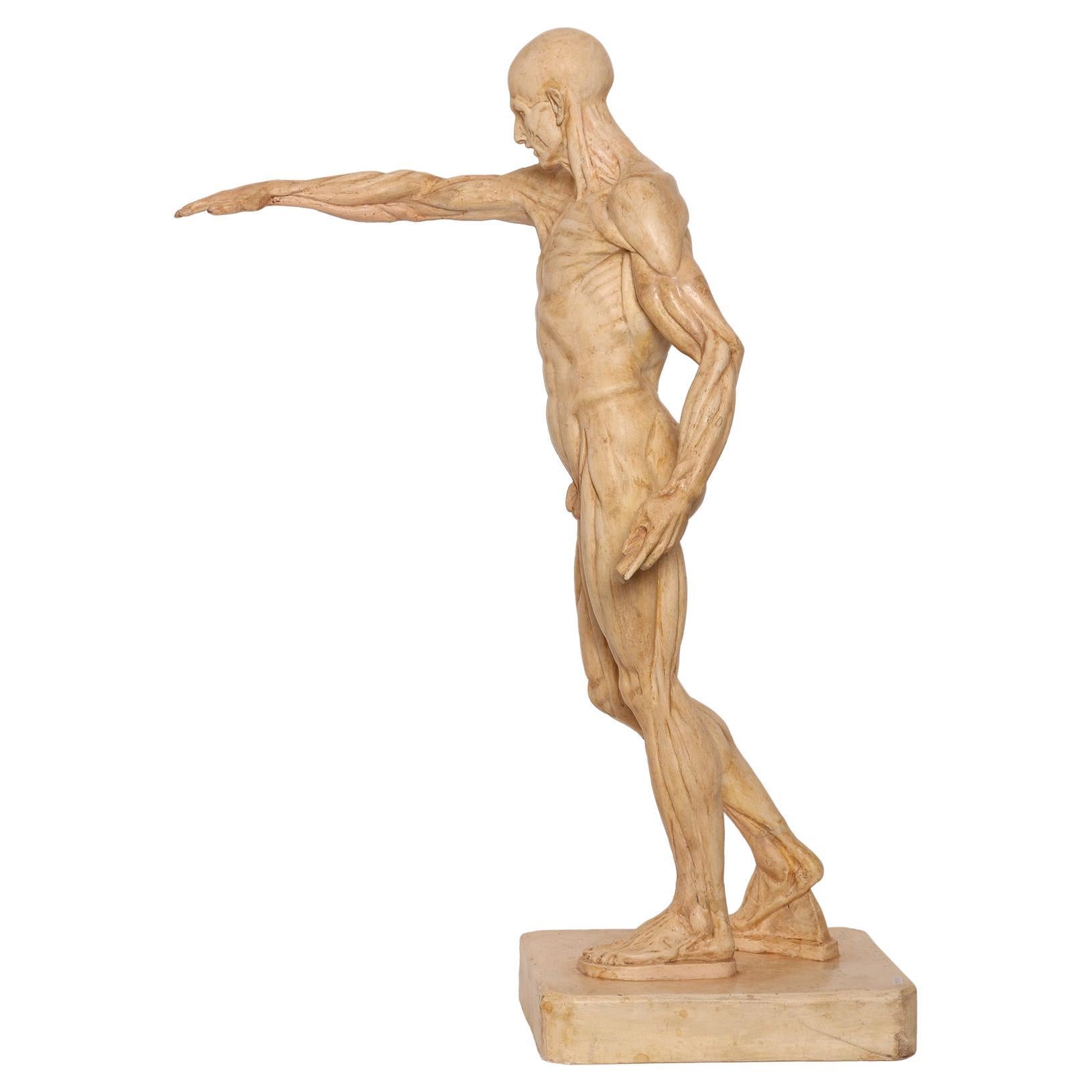Items Similar to Anatomical Model of Gorilla by Dr. Louis Auzoux Plus Unique Handwritten Booklet
Want more images or videos?
Request additional images or videos from the seller
1 of 11
Anatomical Model of Gorilla by Dr. Louis Auzoux Plus Unique Handwritten Booklet
About the Item
Sinke & van Tongeren exhibited this extremely rare Auzoux Gorilla by carefully taking apart the model and creating an exploded view of this historically important piece. When viewed from a particular angle all pieces come together to form the original shape. It was part of the exhibition called ‘TIER’ at MOA in The Netherlands
The story of a remarkable 19th century anatomical model created just four years after Darwin unleashed a political storm with his theories on human evolution.
The publication of Charles Darwin’s controversial On the Origin of Species in 1859 caused debates to rage about human evolution, debates which witnessed the politicisation of a creature whose existence had only recently been confirmed by modern science. On one side of the argument was the Darwinian camp; on the other were those opposed to Darwin’s theory, such as Richard Owen, the famed Director of the Natural History Museum and a man who, interestingly, coined the word ‘dinosaur’.
Tales of the creature in question had endured for centuries, but up until 1847 it remained a myth, an unknown. This all changed thanks to the missionary Thomas Savage and the anatomist Jeffries Wyman who wrote a paper for the journal of the Boston Society of Natural History in which they described a new species: Troglodytes gorilla. (Later, in 1929, Harvard zoologist Harold Coolidge would apply the synonym Gorilla gorilla that we still use today.)
Despite only recently being formally introduced to the gorilla — a creature Darwin argued was among its closest relations, mankind’s first encounters very likely took place in the 5th century B.C. when the Carthaginian Hanno the Navigator recorded coming across ‘women with hairy bodies, whom our interpreters called “gorillae”’. Later, Pliny recorded in his Natural History that their furs were preserved until the Battle of Carthage (149 B.C.).
As a response to this increased public interest, the French naturalist and anatomical model maker Dr. Louis Auzoux announced that he was keen to dissect an ape as his next challenge. He mentioned as much to the Emperor Napoleon III when presenting to the family a lecture on anatomy. The Emperor duly obliged and organised for a specimen preserved in alcohol to be transported back to France from an 1863 expedition to Gabon.
As a theatrical act of scientific teaching, Auzoux dissected the gorilla to demonstrate its anatomy. The dissection took place in front of a crowd at the amphitheatre of the Ecole de Médecine in Paris. Later, a full size model of the gorilla was announced in the journal Le Cosmos; revue des sciences et de leurs applications as an upcoming new addition to the works of Auzoux.
Dr. Auzoux was a leading pioneer of three-dimensional didactic models which he made with a secret recipe containing not only paper but also clay and cork (pieces of which can be seen in this specimen). These models, which he called ‘anatomie clastique’ (from the Greek ‘klastos’, meaning broken in pieces), were specifically designed to be taken apart, piece-by-piece as if carrying out a dissection, in order to facilitate the teaching of students in universities.
Each part of the model would have carried applied numbered labels and arrows instructing the student as to which piece to remove next. The lack of these on the this example points to it being the initial prototype by Auzoux, from which moulds were then taken before being cast and then carefully painted and numbered. The pose for the Gorilla perhaps apes an 1858 lithograph by Marie Firmin Bocourt that appeared in the Archives du Muséum d’Histoire Naturelle vol. X.
Starting out by making models of human legs and other human anatomical models — his first was presented to the Académie Royale de Médecin and earned him a commission, Auzoux recognised a gap in the market with the lack of materials for medical students. Fresh bodies could only be dissected and used for teaching so often before turning, and the industry for providing dissectible wax teaching models was not well established and prohibitively expensive.
Auzoux capitalised on the situation, founding a long-running and successful company providing schools and universities around the world with expertly made and durable didactic models. His catalogue eventually listed 110 models, and the commissaries of the Académie Royale de Médecin frequently praised the importance of the models, in 1831 reporting that ‘France has the advantage of surpassing the other countries in the art of anatomical imitations’. Auzoux was made a member of the Légion d’Honneur.
Today his anatomical models are highly sought after for both their scientific and artistic merits, and can be seen in museum collections from India through Europe to the U.S.
The Gorilla is perhaps his most ambitious of all the models; in 1869 it was advertised at a price of 3,000 Francs. It is certainly the rarest, only four are known: in Paris at the Musée Histoire Naturelle, one in a private museum, another in La Musée d’Anatomie Montpelier (formerly in the collection Delmas-Orfla-Rouvière), and the current example. Even more rare is the autograph manuscript that accompanies this rare prototype model. Titled ‘Anatomie clastique du docteur Auzoux Tableau Synoptique du Gorille’. 65 handwritten pages describing the 1,193 removable pieces of the Gorilla’s anatomy. A unique and original document that completes this important piece of natural history and science.
- Creator:Dr. Louis Auzoux (Maker)
- Dimensions:Height: 66.93 in (170 cm)Width: 35.44 in (90 cm)Depth: 31.5 in (80 cm)
- Materials and Techniques:
- Place of Origin:
- Period:
- Date of Manufacture:1863
- Condition:Wear consistent with age and use.
- Seller Location:Haarlem, NL
- Reference Number:1stDibs: LU102948991091
About the Seller
5.0
Vetted Seller
These experienced sellers undergo a comprehensive evaluation by our team of in-house experts.
1stDibs seller since 2014
24 sales on 1stDibs
- ShippingRetrieving quote...Ships From: Haarlem, Netherlands
- Return PolicyThis item cannot be returned.
More From This SellerView All
- Fine Taxidermy Tower of Owls by Sinke & Van TongerenBy Sinke & Van TongerenLocated in Haarlem, NLWe found this beautiful ornament years ago in a London antique shop. We immediately thought ‘Owls!’ But had to wait for four years to collect the right species that matched the measu...Category
21st Century and Contemporary European Victorian Taxidermy
MaterialsAnimal Skin
- Duo of Fine Taxidermy Ring-Tailed Coatis by Sinke & Van TongerenBy Sinke & Van TongerenLocated in Haarlem, NLA cute artwork with two young Ring-tailed Coatis (Nasua nasua) playing with a piece of fruit. Set on a wooden plinth. This object is currently on display at JAMB, Pimlico Rd, Lond...Category
21st Century and Contemporary Dutch Taxidermy
MaterialsOther
- Fine Taxidermy Magnificent Bird of Paradise by Sinke & Van TongerenBy Sinke & Van TongerenLocated in Haarlem, NLMagnificent Bird of Paradise really is the official name for this species. Have a closer look to see why. Being able to work on a bird of paradise certainly is a privilege. But th...Category
21st Century and Contemporary European Victorian Taxidermy
MaterialsAnimal Skin
- Fine Taxidermy American Flamingo Inspired by Audubon by Sinke & Van TongerenBy Sinke & Van TongerenLocated in Haarlem, NLThe Haarlem taxidermists Jaap Sinke and Ferry van Tongeren have recreated Audubon’s iconic flamingo especially for the ‘Vogelpracht’ exhibition at Teylers Museum. As an artist, John James Audubon is one of the sources of inspiration for their own work. Birds in this work are an American flamingo. A Grey headed swamphen that is mainly a blue-ish green. And an elegant Giant wood rail. Plus the tail of a Ring necked...Category
21st Century and Contemporary European Victorian Taxidermy
MaterialsAnimal Skin
- Fine Taxidermy Kea by Sinke & Van TongerenBy Sinke & Van TongerenLocated in Haarlem, NLThe Kea (Nestor notabilis) is a species of large parrot found in the forested and alpine regions of the South Island of New Zealand. Known for attacking livestock, especially sheep. There are also anecdotal reports of kea attacking rabbits, dogs, and even horses. There are also suggestions that kea used to feed on moa in a similar way. It all sounds brutal yet if looks beautiful. With its mostly olive-green plumage with orange feathers on the undersides of its wings. The outer wing are a dull-blu. It sits on top of a green marble ornament and under a large antique glass dome...Category
21st Century and Contemporary Dutch Victorian Taxidermy
MaterialsAnimal Skin
- Fine Taxidermy Hamerkop by Sinke & Van TongerenBy Sinke & Van TongerenLocated in Haarlem, NLHammerhead (Scopus umbretta) is a medium sized wading bird. The shape of his head with a long bill and crest at the back looks like a hammer. This gave the species its name after the Afrikaans word for hammerhead ‘Hamerkop’. We sculpted this Hamerkop in a very gracious and friendly pose. Its base is tailor made with antique wood and velvet. Housend under an antique 19th century glass dome...Category
21st Century and Contemporary Dutch Victorian Taxidermy
MaterialsAnimal Skin
You May Also Like
- Set of 2 Didactic Dr. Auzoux Molding, Internal Organs + Starfish Transversal CutBy Dr. Louis AuzouxLocated in Leuven , BEMoldings labeled "Auzoux 9 rue de l'Ecole de Médecine Paris 6e". Dimensions: Internal organs 54 x 36 Starfish 42 x 43.5.Category
Antique Early 1900s French Figurative Sculptures
MaterialsPlaster
- Louis Thomas Jérôme Auzoux (1797-1880) - Skinned, Human anatomical ModelBy Dr. Louis AuzouxLocated in Bruxelles, BELouis Thomas Jérôme Auzoux (1797-1880) Skinned Human anatomical Model Paris, around 1850 135 cm In the 1820s Louis Auzoux, a French medical graduate ...Category
Antique Mid-19th Century French Other Figurative Sculptures
MaterialsPaper
- Somso Anatomical Horse Model, 1950sBy SomsoLocated in Antwerp, BESomso anatomical horse model - zoology model - veterinary model. This vintage school model - educational model dates circa 1950s and is made of plaster ...Category
Mid-20th Century German Modern Models and Miniatures
MaterialsPlaster, Wood
- Anatomical Skin Model, Italy, 1880Located in Milan, ITThe anatomical sculpture, cast out of plaster, depicts a flayed man standing over a rectangular base in a classical pose with lifted arm. Anatomical study p...Category
Antique Late 19th Century Italian Figurative Sculptures
MaterialsPlaster
- Anatomical model of the lower limb, Italy 1900.Located in Milan, ITAnatomical model for schools, didactic use, depicting the lower limb, tilting on a fork supported by a black lacquered wooden base. Made in scagliola and finished entirely in colour....Category
Early 20th Century Italian Scientific Instruments
MaterialsScagliola, Wood
- Anatomical Model of the Upper Limbs, Italy 1900Located in Milan, ITAnatomical model for schools, didactic use, depicting the upper limb tilting on a fork supported by a black lacquered wooden base. Made in plaster and finished entirely in colour. F...Category
Early 20th Century Italian Scientific Instruments
MaterialsScagliola
Recently Viewed
View AllMore Ways To Browse
Aero Desk
Vintage Brass Air Pump
Antique Metal Doll Bed
Miniature Log Cabins
Retro Lawn Glider
Rob Arad
Salesman Sample Bauhaus
Tuiga 1909
Vintage Lawn Furniture Glider
Vintage Lawn Glider
Vintage Lawn Gliders
Vintage Tire Pump
Vintage Tire Pumps
Dooling Tether Car
Eames Lcm Vitra
Ferrari Arno
Ferrari Hydroplane
M1 Carbine





